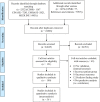Clinical prediction models for mortality and functional outcome following ischemic stroke: A systematic review and meta-analysis
- PMID: 29377923
- PMCID: PMC5788336
- DOI: 10.1371/journal.pone.0185402
Clinical prediction models for mortality and functional outcome following ischemic stroke: A systematic review and meta-analysis
Abstract
Objective: We aim to identify and critically appraise clinical prediction models of mortality and function following ischaemic stroke.
Methods: Electronic databases, reference lists, citations were searched from inception to September 2015. Studies were selected for inclusion, according to pre-specified criteria and critically appraised by independent, blinded reviewers. The discrimination of the prediction models was measured by the area under the curve receiver operating characteristic curve or c-statistic in random effects meta-analysis. Heterogeneity was measured using I2. Appropriate appraisal tools and reporting guidelines were used in this review.
Results: 31395 references were screened, of which 109 articles were included in the review. These articles described 66 different predictive risk models. Appraisal identified poor methodological quality and a high risk of bias for most models. However, all models precede the development of reporting guidelines for prediction modelling studies. Generalisability of models could be improved, less than half of the included models have been externally validated(n = 27/66). 152 predictors of mortality and 192 predictors and functional outcome were identified. No studies assessing ability to improve patient outcome (model impact studies) were identified.
Conclusions: Further external validation and model impact studies to confirm the utility of existing models in supporting decision-making is required. Existing models have much potential. Those wishing to predict stroke outcome are advised to build on previous work, to update and adapt validated models to their specific contexts opposed to designing new ones.
Conflict of interest statement
Figures
References
-
- Feigin VL, Roth GA, Naghavi M, Parmar P, Krishnamurthi R, Chugh S, et al. Global burden of stroke and risk factors in 188 countries, during 1990–2013: a systematic analysis for the Global Burden of Disease Study 2013. Lancet Neurology 2016; 15:913–924. doi: 10.1016/S1474-4422(16)30073-4 - DOI - PubMed
-
- D’Agostino RD, Vasan RS, Pencina MJ, Wolf PA, Cobain M, Massaro JM, et al. General Cardiovascular Risk Profile for Use in Primary Care: The Framingham Heart Study. Circulation 2008; 117; 743–753. doi: 10.1161/CIRCULATIONAHA.107.699579 - DOI - PubMed
-
- Hippisley-Cox J, Coupland C, Vinogradova Y, Robson J, May M, Brindle P. Derivation and validation of QRISK, a new cardiovascular disease risk score for the United Kingdom: prospective open cohort study. BMJ 2007;335(7611):136 doi: 10.1136/bmj.39261.471806.55 - DOI - PMC - PubMed
-
- Ridker PM, Paynter NP, Rifai N, Gaziano JM, Cook NR. C-reactive protein and parental history improve global cardiovascular risk prediction: the Reynolds Risk Score for men. Circulation 2008;118:2243–2251. doi: 10.1161/CIRCULATIONAHA.108.814251 - DOI - PMC - PubMed
-
- Ridker PM, Paynter NP, Rifai N, Gaziano JM, Cook NR. C-reactive protein and parental history improve global cardiovascular risk prediction: the Reynolds Risk Score for men. Circulation 2008;118:2243–2251. doi: 10.1161/CIRCULATIONAHA.108.814251 - DOI - PMC - PubMed
Publication types
MeSH terms
LinkOut - more resources
Full Text Sources
Other Literature Sources
Medical






